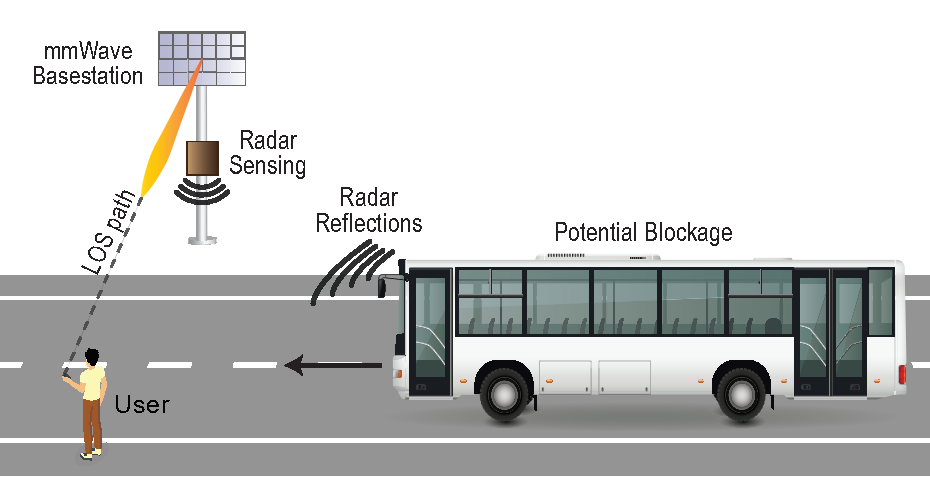Radar Aided Proactive Blockage Prediction in Real-World Millimeter Wave Systems

The future LOS blockages are can be predicted by the radar sensing in mobile environments to provide performance advantages for reliability, latency and data rates.
Key ideas
- The radar measurements can be leveraged to sense the environment
- With the sensed environment, the future LOS blockages can be predicted
- For the real-world data, deep learning methods present robust solutions and can be utilized to predict the beams from the radar measurements
Applications
- mmWave and THz blockage prediction
- Proactive handover for potential performance drops
More information about this research direction
Paper: Umut Demirhan and Ahmed Alkhateeb, “Radar Aided Proactive Blockage Prediction in Real-World Millimeter Wave Systems,” arXiv preprint arXiv:2111.14805 (2021).
Abstract: Millimeter wave (mmWave) and sub-terahertz communication systems rely mainly on line-of-sight (LOS) links between the transmitters and receivers. The sensitivity of these high-frequency LOS links to blockages, however, challenges the reliability and latency requirements of these communication networks. In this paper, we propose to utilize radar sensors to provide sensing information about the surrounding environment and moving objects, and leverage this information to proactively predict future link blockages before they happen. This is motivated by the low cost of the radar sensors, their ability to efficiently capture important features such as the range, angle, velocity of the moving scatterers (candidate blockages), and their capability to capture radar frames at relatively high speed. We formulate the radar-aided proactive blockage prediction problem and develop two solutions for this problem based on classical radar object tracking and deep neural networks. The two solutions are designed to leverage domain knowledge and the understanding of the blockage prediction problem. To accurately evaluate the proposed solutions, we build a large-scale real-world dataset, based on the DeepSense framework, gathering co-existing radar and mmWave communication measurements of more than 10 thousand data points and various blockage objects (vehicles, bikes, humans, etc.). The evaluation results, based on this dataset, show that the proposed approaches can predict future blockages 1 second before they happen with more than 90% F1 score (and more than 90% accuracy). These results, among others, highlight a promising solution for blockage prediction and reliability enhancement in future wireless mmWave and terahertz communication systems.
@misc{Demirhan2021,
title={Radar Aided Proactive Blockage Prediction in Real-World Millimeter Wave Systems},
author={Demirhan, Umut and Alkhateeb, Ahmed},
year={2021},
eprint={2111.14805},
archivePrefix={arXiv},
primaryClass={eess.SP}}
To reproduce the results in this paper:
Simulation codes:
Coming soon
These simulations use the DeepSense scenarios:
Scenario "30"
Example: Steps to generate the results in this figure
- coming soon

